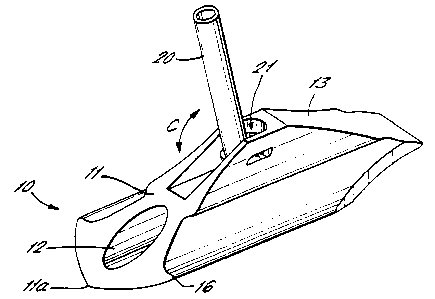Une partie des informations de ce site Web a été fournie par des sources externes. Le gouvernement du Canada n'assume aucune responsabilité concernant la précision, l'actualité ou la fiabilité des informations fournies par les sources externes. Les utilisateurs qui désirent employer cette information devraient consulter directement la source des informations. Le contenu fourni par les sources externes n'est pas assujetti aux exigences sur les langues officielles, la protection des renseignements personnels et l'accessibilité.
L'apparition de différences dans le texte et l'image des Revendications et de l'Abrégé dépend du moment auquel le document est publié. Les textes des Revendications et de l'Abrégé sont affichés :
| (12) Brevet: | (11) CA 2175673 |
|---|---|
| (54) Titre français: | AMELIORATIONS APPORTEES A DES TIRANTS D'ANCRAGE |
| (54) Titre anglais: | IMPROVEMENTS IN GROUND ANCHORS |
| Statut: | Durée expirée - au-delà du délai suivant l'octroi |
| (51) Classification internationale des brevets (CIB): |
|
|---|---|
| (72) Inventeurs : |
|
| (73) Titulaires : |
|
| (71) Demandeurs : |
|
| (74) Agent: | RICHES, MCKENZIE & HERBERT LLP |
| (74) Co-agent: | |
| (45) Délivré: | 2004-12-07 |
| (86) Date de dépôt PCT: | 1994-05-18 |
| (87) Mise à la disponibilité du public: | 1995-05-11 |
| Requête d'examen: | 2000-04-03 |
| Licence disponible: | S.O. |
| Cédé au domaine public: | S.O. |
| (25) Langue des documents déposés: | Anglais |
| Traité de coopération en matière de brevets (PCT): | Oui |
|---|---|
| (86) Numéro de la demande PCT: | PCT/GB1994/001066 |
| (87) Numéro de publication internationale PCT: | WO 1995012713 |
| (85) Entrée nationale: | 1996-05-02 |
| (30) Données de priorité de la demande: | ||||||
|---|---|---|---|---|---|---|
|
L'invention se rapporte à des tirants d'ancrage (10) du type de ceux qui sont fixés à des câbles et à des barres, enfoncés dans le sol puis basculés transversalement par tension du câble. Un tirant d'ancrage comprend un corps (11) généralement de coupe triangulaire, s'étendant sensiblement sur sa longueur, doté de côtés généralement concaves ainsi que d'une surface inférieure continue convexe s'étendant à partir d'un bord de la portion du corps où se rencontrent les côtés et la surface inférieure, jusqu'au bord opposé.
The invention relates to ground anchors (10) of the type which are attached to cables and rods and driven into the ground and tilted
transversely by tensioning the cable. A ground anchor comprising a body portion (11) having a generally triangular cross section extending
substantially along its length having generally concave sides and a continuous convex lower surface from one edge of the body portion
where the sides and lower suface meet to an opposite edge.
Note : Les revendications sont présentées dans la langue officielle dans laquelle elles ont été soumises.
Note : Les descriptions sont présentées dans la langue officielle dans laquelle elles ont été soumises.

2024-08-01 : Dans le cadre de la transition vers les Brevets de nouvelle génération (BNG), la base de données sur les brevets canadiens (BDBC) contient désormais un Historique d'événement plus détaillé, qui reproduit le Journal des événements de notre nouvelle solution interne.
Veuillez noter que les événements débutant par « Inactive : » se réfèrent à des événements qui ne sont plus utilisés dans notre nouvelle solution interne.
Pour une meilleure compréhension de l'état de la demande ou brevet qui figure sur cette page, la rubrique Mise en garde , et les descriptions de Brevet , Historique d'événement , Taxes périodiques et Historique des paiements devraient être consultées.
| Description | Date |
|---|---|
| Inactive : Périmé (brevet - nouvelle loi) | 2014-05-18 |
| Inactive : CIB de MCD | 2006-03-12 |
| Inactive : CIB de MCD | 2006-03-12 |
| Inactive : CIB de MCD | 2006-03-12 |
| Accordé par délivrance | 2004-12-07 |
| Inactive : Page couverture publiée | 2004-12-06 |
| Préoctroi | 2004-09-22 |
| Inactive : Taxe finale reçue | 2004-09-22 |
| Un avis d'acceptation est envoyé | 2004-08-04 |
| Lettre envoyée | 2004-08-04 |
| Un avis d'acceptation est envoyé | 2004-08-04 |
| Inactive : Approuvée aux fins d'acceptation (AFA) | 2004-07-15 |
| Modification reçue - modification volontaire | 2003-11-25 |
| Inactive : Dem. de l'examinateur par.30(2) Règles | 2003-10-07 |
| Modification reçue - modification volontaire | 2003-06-06 |
| Inactive : Dem. de l'examinateur par.30(2) Règles | 2002-12-06 |
| Modification reçue - modification volontaire | 2000-06-27 |
| Modification reçue - modification volontaire | 2000-05-09 |
| Inactive : Dem. traitée sur TS dès date d'ent. journal | 2000-05-03 |
| Lettre envoyée | 2000-05-03 |
| Inactive : Renseign. sur l'état - Complets dès date d'ent. journ. | 2000-05-03 |
| Exigences pour une requête d'examen - jugée conforme | 2000-04-03 |
| Toutes les exigences pour l'examen - jugée conforme | 2000-04-03 |
| Lettre envoyée | 1999-11-08 |
| Exigences de rétablissement - réputé conforme pour tous les motifs d'abandon | 1999-10-28 |
| Réputée abandonnée - omission de répondre à un avis sur les taxes pour le maintien en état | 1999-05-18 |
| Demande publiée (accessible au public) | 1995-05-11 |
| Date d'abandonnement | Raison | Date de rétablissement |
|---|---|---|
| 1999-05-18 |
Le dernier paiement a été reçu le
Avis : Si le paiement en totalité n'a pas été reçu au plus tard à la date indiquée, une taxe supplémentaire peut être imposée, soit une des taxes suivantes :
Veuillez vous référer à la page web des taxes sur les brevets de l'OPIC pour voir tous les montants actuels des taxes.
Les titulaires actuels et antérieures au dossier sont affichés en ordre alphabétique.
| Titulaires actuels au dossier |
|---|
| PLATIPUS ANCHORS LIMITED |
| Titulaires antérieures au dossier |
|---|
| CHARLES SIMON JAMES AGG |